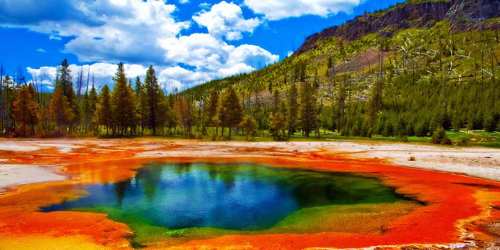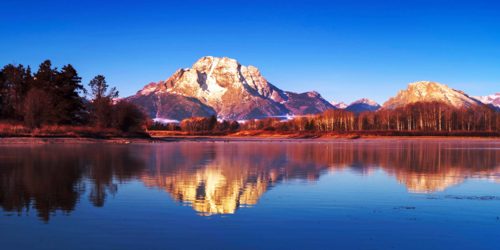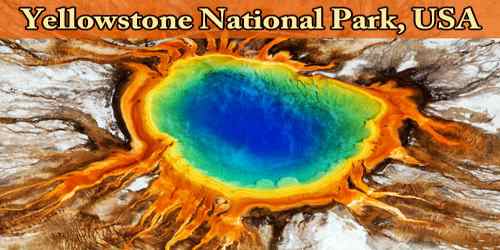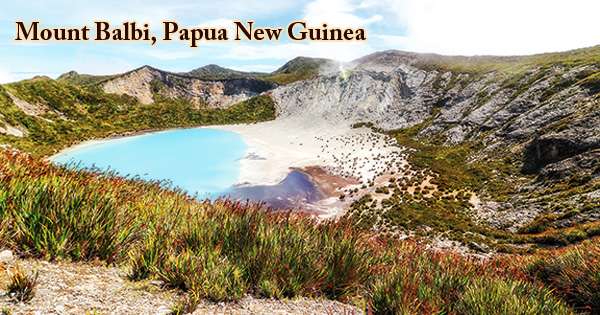Yellowstone National Park, the oldest, one of the largest, is an American national park located in the western United States, with parts in Wyoming, Montana, and Idaho. It was established by the U.S. Congress and signed into law by President Ulysses S. Grant on 1st March 1872. It is also generally considered to have been the first national park in the world, though some naturalists and others have argued that there is evidence that indicates that the creation of Yellowstone was predated by the creation of Bogd Khan Mountain National Park in Mongolia, which may date from as early as 1778. Yellowstone was designated a UNESCO biosphere reserve in 1976 and a World Heritage site in 1978.
Yellowstone National Park’s 2 million acres house majestic peaks and abundant wildlife, as well as the world’s largest concentration of geysers and thermal features. As one of the most beautiful national parks in the USA, many of Yellowstone’s features have been immortalized and made famous through photographs and paintings.
Delight in a hike, watch the sunset, go boating, skiing, snowshoeing, cycling, or simply bask in awe of iconic sites like Old Faithful and Lower Falls. The sights combined with the history of the park make it a perfect destination for a lovely vacation.
The park, which forms a squarelike rectangle with an irregular eastern side, is 63 miles (101 km) from north to south and 54 miles (87 km) from east to west at its widest point and covers an area of 3,472 square miles (8,992 square km). The John D. Rockefeller, Jr., Memorial Parkway, an 80-mile (130-km) scenic roadway that was established in 1972, connects Yellowstone with Grand Teton National Park to the south.
Hundreds of species of mammals, birds, fish, reptiles, and amphibians have been documented, including several that are either endangered or threatened. The vast forests and grasslands also include unique species of plants. Yellowstone Park is the largest and most famous megafauna location in the contiguous United States. Grizzly bears, wolves, and free-ranging herds of bison and elk live in this park. The Yellowstone Park bison herd is the oldest and largest public bison herd in the United States. Forest fires occur in the park each year; in the large forest fires of 1988, nearly one third of the park was burnt. Yellowstone has numerous recreational opportunities, including hiking, camping, boating, fishing and sightseeing. Paved roads provide close access to the major geothermal areas as well as some of the lakes and waterfalls. During the winter, visitors often access the park by way of guided tours that use either snow coaches or snowmobiles.

In addition, Yellowstone is surrounded by Gallatin (northwest and north), Custer (northeast), Shoshone (northeast and east), Bridger-Teton (southeast and south), and Caribou-Targhee (southwest) national forests. Headquarters are at Mammoth Hot Springs near the northern entrance to the park. The park is currently closed to visitors to prevent the spread of COVID-19.
History and Geology –
Yellowstone National Park has rich human and ecological stories that continue to unfold. People have spent time in the Yellowstone region for more than 11,000 years. Many tribes and bands used the park as their home, hunting grounds, and transportation routes prior to and after European American arrival. Yellowstone was established as the world’s first national park in 1872.
The park contains the headwaters of the Yellowstone River, from which it takes its historical name. Near the end of the 18th century, French trappers named the river Roche Jaune, which is probably a translation of the Hidatsa name Mi tsi a-da-zi (“Yellow Rock River”). Later, American trappers rendered the French name in English as “Yellow Stone”. Although it is commonly believed that the river was named for the yellow rocks seen in the Grand Canyon of the Yellowstone, the Native American name source is unclear.
The human history of the Yellowstone region goes back more than 11,000 years. The stories of people in Yellowstone are preserved in archeological sites and objects that convey information about past human activities in the region, and in people’s connections to the land that provide a sense of place or identity.
Management and control of the park originally fell under the jurisdiction of the United States Department of the Interior, the first Secretary of the Interior to supervise the park being Columbus Delano. However, the U.S. Army was eventually commissioned to oversee management of Yellowstone for a 30-year period between 1886 and 1916. In 1917, administration of the park was transferred to the National Park Service, which had been created the previous year. Hundreds of structures have been built and are protected for their architectural and historical significance, and researchers have examined more than a thousand archaeological sites.
Yellowstone is situated in a region that has been volcanically and seismically active for tens of millions of years. Tectonic movement of the North American Plate has thinned Earth’s crust in the area, forming a hot spot (a place where a dome of magma, or molten rock, comes close to the surface). About 2.1 million years ago a subsurface magma dome that had been building up in the Yellowstone area blew up in one of the world’s most cataclysmic volcanic eruptions. Some 600 cubic miles (2,500 cubic km) of rock and ash were ejected; equivalent to about 6,000 times the amount of volcanic material that was released during the eruption of Mount Saint Helens in 1980. (Observations made in the early 21st century indicated that this single eruption actually consisted of two events about 6,000 years apart: one very large and a second much smaller one. Subsequent massive eruptions occurred about 1,300,000 and 640,000 years ago the last event (consisting in large part of lava flows) producing about two-fifths as much material as the first one.
Each of those eruptions caused the magma dome that had built up to collapse as its contents were released, leaving an enormous caldera. The present-day Yellowstone Caldera, the product of the third eruption, is a roughly oval-shaped basin some 30 by 45 miles (50 by 70 km) that occupies the west-central portion of the national park and includes the northern two-thirds of Yellowstone Lake. Two resurgent magma domes one just north of and the other just west of Yellowstone Lake have been forming in the caldera, and the western dome underlie many of the park’s best-known hydrothermal features.
Rivers and lakes cover five percent of the land area, with the largest water body being Yellowstone Lake at 87,040 acres (352 km2; 136 sq mi). Yellowstone Lake is up to 400 feet (120 m) deep and has 110 miles (180 km) of shoreline. At an elevation of 7,733 feet (2,357 m) above sea level, Yellowstone Lake is the largest high elevation lake in North America. Forests comprise 80 percent of the land area of the park; most of the rest is grassland.
Yellowstone National Park has one of the world’s largest petrified forests, trees that were long ago buried by ash and soil and transformed from wood to mineral materials. This ash and other volcanic debris are believed to have come from the parking area itself as the central part of Yellowstone is the massive caldera of a super-volcano. The park contains 290 waterfalls of at least 15 feet (4.6 m), the highest being the Lower Falls of the Yellowstone River at 308 feet (94 m).
Three deep canyons are located in the park, cut through the volcanic tuff of the Yellowstone Plateau by rivers over the last 640,000 years. The Lewis River flows through Lewis Canyon in the south, and the Yellowstone River has carved two colorful canyons, the Grand Canyon of the Yellowstone and the Black Canyon of the Yellowstone in its journey north.

Climate –
Yellowstone’s climate can be described as cool temperate and continental. It is also considerably variable, influenced by the park’s high average elevation, relatively high latitude, location deep within the continent, and mountainous terrain. In general, the north-central portion of Yellowstone tends to have wetter summers and drier winters than the rest of the park, where the moisture regimens are reversed. Temperatures almost always decrease with elevation gain. Because of Yellowstone’s large area and variegated topography, weather conditions at different locations within the park can vary widely at any given time. In addition, conditions can change dramatically in a short period of time at one location.
Summer days are warm and relatively sunny, with daytime temperatures reaching about 80 °F (27 °C) in July at lower elevations before dropping to nighttime lows in the 40s or 50s F (about 10 °C); temperatures are usually cooler higher in the mountains. Although precipitation totals in the warm months generally are light, summer afternoon thunderstorms are common. Winters are cold and snowy, as temperatures rarely rise above the mid-20s F (about −4 °C) and often drop to 0 °F (−18 °C) or lower at night. Annual precipitation amounts vary with location and elevation, being lowest in the north (about 10 inches (250 mm)) and highest on the western slopes of the northern Teton foothills (about 80 inches (2,000 mm)). Snowfall is heavy in most areas, especially at higher elevations, and typically begins in early autumn and continues into April or May.
There have been six earthquakes with at least magnitude 6 or greater in historical times, including the 7.2‑magnitude Hebgen Lake earthquake which occurred just outside the northwest boundary of the park in 1959. A 6.1‑magnitude earthquake struck inside the park on June 30, 1975, but damage was minimal. On March 30, 2014, a magnitude 4.8 earthquake struck almost the very middle of Yellowstone near the Norris Basin at 6:34 am; reports indicated no damage. This was the largest earthquake to hit the park since February 22, 1980.

Biology and Ecology –
Yellowstone’s relief is the result of tectonic activity (volcanism and earthquakes) combined with the erosional actions of ice and water. Most of the park consists of broad volcanic plateaus with an average elevation of about 7,875 feet (2,400 meters). Three mountain ranges, each aligned roughly north to south, protrude into the park: the Gallatin Range in the northwest, the Absaroka Range in the east, and the northern extremity of the Teton Range along the park’s southwestern boundary. The tallest mountains in the park are in the Absarokas, where many summits exceed elevations of 10,000 feet (3,050 meters). The range’s Eagle Peak, on the park’s boundary in the southeast, is the high point, reaching 11,358 feet (3,462 meters). Aside from its rugged mountains and spectacular deep glacier-carved valleys, the park has unusual geologic features, including fossil forests, eroded basaltic lava flows, a black obsidian (volcanic glass) mountain, and odd erosional forms.
There are dozens of species of flowering plants that have been identified, most of which bloom between the months of May and September. The Yellowstone sand verbena is a rare flowering plant found only in Yellowstone. It is closely related to species usually found in much warmer climates, making the sand verbena an enigma. The estimated 8,000 examples of this rare flowering plant all make their home in the sandy soils on the shores of Yellowstone Lake, well above the waterline.
In Yellowstone’s hot waters, bacteria form mats of bizarre shapes consisting of trillions of individuals. These bacteria are some of the most primitive life forms on earth. Flies and other arthropods live on the mats, even in the middle of the bitterly cold winters. Initially, scientists thought that microbes there gained sustenance only from sulfur.
Yellowstone is also known for its many scenic lakes and rivers. The park’s largest body of water is Yellowstone Lake, which, having a surface area of 132 square miles (342 square km) and lying at an elevation of 7,730 feet (2,356 meters), is the highest mountain lake of its size in North America. The West Thumb area a knoblike protrusion of the lake on its west side was formed by a relatively small eruption in the caldera about 150,000 years ago. The next largest lake, Shoshone Lake, lies in the caldera southwest of Yellowstone Lake.
Yellowstone is widely considered to be the finest megafauna wildlife habitat in the lower 48 states. There are almost 60 species of mammals in the park, including the Rocky Mountain wolf, coyote, the Canadian lynx, cougars, and black and grizzly bears. Other large mammals include the bison (often referred to as buffalo), elk, moose, mule deer, white-tailed deer, mountain goat, pronghorn, and bighorn sheep. Common smaller mammals include badgers, martens, weasels, river otters, hares and rabbits, shrews, a variety of bats, and many species of small rodents. Wolves were successfully reintroduced into Yellowstone in 1995 and are now found throughout much of the park. Beavers have also made a significant comeback, and several hundred live along streams and lakes, mainly in the northwest, southeast, and southwest.
More than 300 different species of birds have been identified as living year-round or seasonally in Yellowstone or migrating through the park in spring and autumn. Roughly half of that total nest there during the summer. Songbirds and woodpeckers constitute the greatest number of species. Among the permanent residents are jays, chickadees, nuthatches, ravens, and waterfowl such as trumpeter swans and Canada geese. Summer breeders of interest include sandhill cranes, white pelicans, and common loons with Yellowstone representing one of the southernmost points that the latter group reaches in North America. The populations of three of the park’s raptors bald eagles, ospreys, and peregrine falcons have made significant recoveries after having been severely depleted in the mid-20th century. Each species has been the subject of a long-term study and monitoring program in Yellowstone.
Today, park managers use archeological and historical studies to help us understand how people lived here in the past. Ethnography helps us learn about how groups of people identify themselves and their connections to the park. Research is also conducted to learn how people continue to affect and be affected by these places, many of which have been relatively protected from human impacts. Some alterations to the landscape, such as the construction of roads and other facilities, are generally accepted as necessary to accommodate the needs of visitors today. Information on the possible consequences of modern human activities, both inside and outside the parks, is used to determine how best to preserve Yellowstone’s natural and cultural resources and the quality of the visitors’ experience.
Information Sources:
















